3He(e,e'd) Asymmetries
1.) Analyzed all (vast majority) of data.
I have now on my computer rootfiles of 961 production runs. Now I can
determine asymmetries for all kinematics.
Rotation of the results
Here is a short pdf with the description of the coordinate system
and used rotation. I also included a check, that confirms that at least
elastic asymmetries can be rotated. The main problem with these rotation
is the additional error on the results due to the uncertainty of the
angle:
Asymmetry1.pdf
Here are ROTATED results from last week:
01.) 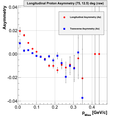 02.)
02.) 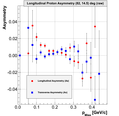 03.)
03.) 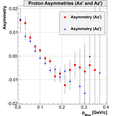 04.)
04.) 
New Results for (BB, HRSL)=(-75, 12.5)deg:
05.) 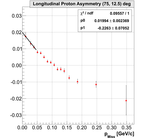 06.)
06.) 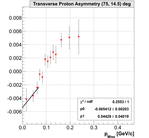
New Results for (BB, HRSL)=(-75, 14.5)deg:
07.) 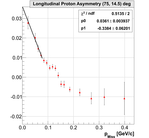 08.)
08.) 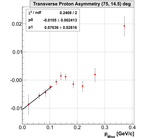
New Results for (BB, HRSL)=(-82, 14.5)deg:
09.) 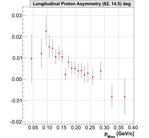
These data have same kinematics settings as (75, 14.5)deg data. The
only difference between the two is the \theta_{pq} angle. Can this
cause observed difference in the results.
10.) 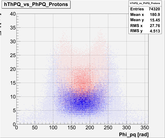 11.)
11.) 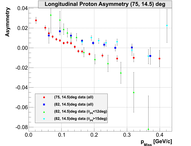
3GeV Longitudinal Results:
12.) 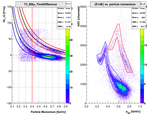 13.)
13.) 
Elastic Proton asymmetry:
I was trying to determine the polarization of protons inside the 3He.
Here is a short description of the procedure:
Asymmetry2.pdf
We plot data as function of the theta* at fixed values of Q**2. The
only free parameter is multiplication factor, that depends on the
polarization of the protons:
14.) 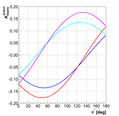 15.)
15.) 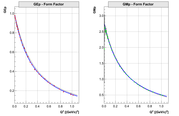 16.)
16.) 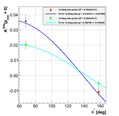
ZLIB problem
I am still having problems with the crashing of the analysis, due
to the ZLIB problem. Until recently I though that runs, that first
crash but later automatically recover, are good. However, I realized that in
some cases I get strange results even if only run is bad. Please see
figures below.
17.) 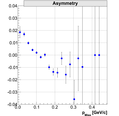 18.)
18.) 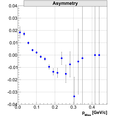
Left figure shows results that I got when I considered run #3229, that
crashed in the middle of the analysis (but eventually came successful
to the end). You can see how point at p_miss=0.14GeV is moved to higher
value. This happens because of this bad analysis of the run #3229.
Later I reanalyzed this run, this time without any errors and got
completely different results. This brings important message, that
this problem can not be swiped under the rug
Therefore I went into the analyzer code and realized that by default
level 1 compression is being used, which considers Lempel-Ziv-Markov
compression algorithm. I set the compression level to zero and restarted
the analysis on FARM. Until now I was able to analyze approx. 50 runs.
None of them reported errors. Without compression analysis seems to
be working better. Unfortunately this kind of analysis requires
approx. six times more disk space (800MB -> 5GB)
Checked my algorithm for the rotation of the asymmetries
I have also checked algorithm, that I used to rotate asymmetries
from LAB coordinate-system to the "q-CS". I believe that my code
was correct. I also believe that asymmetries that I showed you
last week should be the same at low p_miss, with the same sign.
When looking at the elastic proton asymmetries at the same Q**2,
one can see that these asymmetries (A_perp, A_par) at given Q^2
should be approx. of the same size. I will show you more detailed results
next week.
Last modified: 10/05/11
 02.)
02.)  03.)
03.)  04.)
04.) 
 06.)
06.) 
 08.)
08.) 

 11.)
11.) 
 13.)
13.) 
 15.)
15.)  16.)
16.) 
 18.)
18.) 